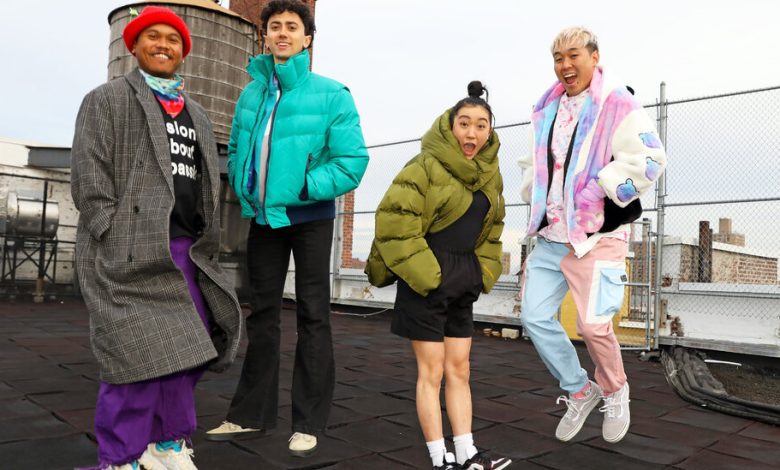‘Bzzz’ Turns Art Forms of Solo Virtuosity Into a Group Affair

The acclaimed tap dancer Caleb Teicher and the world-champion beatboxer Chris Celiz might seem to belong to very different tribes. But when they met a few years ago while separately performing at a conference in Miami, they got to talking about what their art forms had in common.
“They’re both body music,” Teicher said recently. “And they use parts of the body” — feet, the mouth — “that you might consider limited or niche. You could argue that tap dance has tonal limitations, and you could say the same about beatbox. But there’s no limit to how they excite our imaginations.”
Both styles, they realized, grew out of Black American traditions: jazz and hip-hop. “And so they share ideas of call and response, virtuosity, competition, humor,” Teicher said. “All these things are kind of in the same cauldron.”
What might happen, they wondered, if they combined their skills?
The result of just that was “Bzzz,” a raucous, 15-minute work created for Fall for Dance at New York City Center in 2018. The piece was well received by audiences and critics alike, and for the following year, the festival asked them to make it twice as long. Other presenters then suggested expanding it into a stand-alone program, but Teicher and Celiz resisted.
Then, one day in the shower, Teicher had an epiphany that led to the 70-minute version of “Bzzz,” which debuts at the Joyce Theater on Tuesday.
To explain that epiphany requires a bit of a spoiler. In all its versions, “Bzzz” starts with a meet-cute between Celiz and a crew of tap dancers. “It’s a like a science fiction first encounter or a new kid’s first day at school,” Teicher said. Communicating through rhythm, the cast members discover what they can do collectively. The shower idea about how to extend this: What if another beatboxer showed up?
This addition, of the beatboxer Gene Shinozaki, expands a work that is, on one level, about expansion by inclusion. Teicher pointed to an early section during which Celiz and the dancers engage in the musical form called hocketing — each person taking a tiny piece of a rhythmic phrase and playing it down a line like a relay. Here, with each repeat, a new person joins, squeezing in on a small wooden board.
“And the attitude is, ‘Sure, we’ve got space for one more,’” Teicher said. “Tap dancers and beatboxers want to welcome people.”
Celiz emphasized that attitude as a choice, and a kind of maturation. “The biggest lane for beatboxing is competition,” he said. “I started out creating 90-second beatbox routines to be better than someone else. But as you grow, you realize you can do more together.”
Although beatboxers as skilled as Celiz and Shinozaki can suggest many layers of sound individually, it takes two of them to sing in harmony. Similarly, two beatboxers and six tap dancers can do things that one beatboxer and six tap dancers can’t.
“We’re always trying to explore more sonically,” Celiz said. “And because we love what we do, we want to relate it to as many people as possible.”
Hence the tone of “Bzzz”: bright, broad and goofy. Naomi Funaki, the assistant choreographer, likened watching the show to reading comic books. Some bits, including a simulated tennis match, feel like comedy sketches with sound effects supplied by the beatboxers. Other vaudeville touches amid the EDM beats and buzzes and more recent pop cultural references: a curtain that rises to knee level, the old shave-and-a-haircut rhythm returning, again and again.
Both tap and beatboxing seek to astonish — your feet and mouth can do that? — and everything in “Bzzz” tends to ratchet up, accelerate, get crazier, sometimes building to the jump-around energy of a mosh pit. But the manner stays inviting; the call and response sections include the audience.
“With beatbox, there’s a lot of ‘Check out this cool technique!’” Celiz said. “And that’s awesome, but you can also be like, ‘Hey, come be with us.’”
Shinozaki said that the show reminded him of how he entered the beatbox community. “One of the first beatboxers I met was Chris, who has been doing it much longer than I have,” he said. “And I would see him at competitions, and he would invite me to his house and introduce me to other beatboxers.” Now, the two often perform together as the duo Spiderhorse, as well as with a collective called the Beatbox House.
One difference between this version of “Bzzz” and previous ones, aside from length, is that its choreographer, Teicher, doesn’t perform. “I think I’m doing a better job making the piece by not being in it,” Teicher said. “It also means one more job for another tap dancer.”
Such self-abnegation is in tune with the production. Tap dance and beatboxing both tend to celebrate solo virtuosity, “and there are some incredible solos in this show,” Teicher said. “But that’s not the point. The point is how we all get together. That’s something we all feel really passionate about sharing.”




